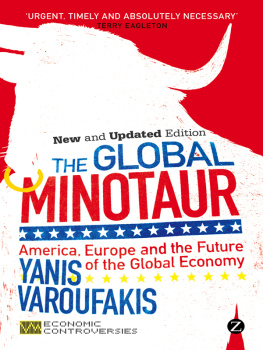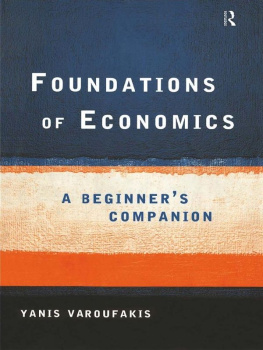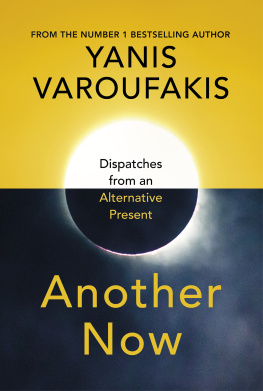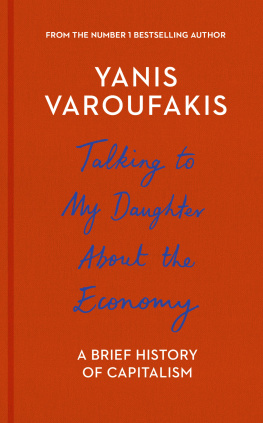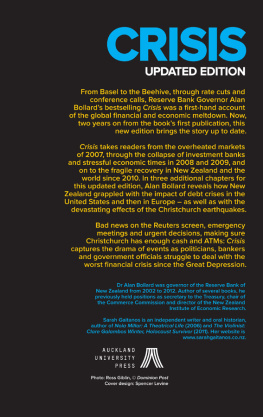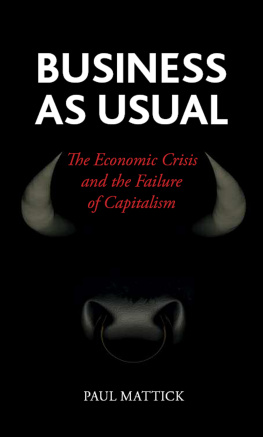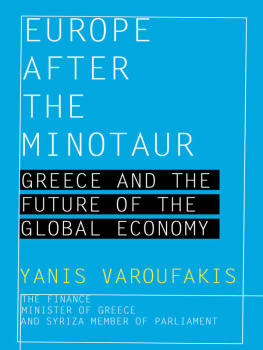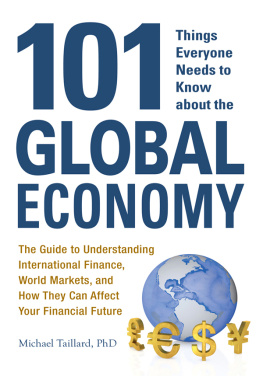
ECONOMIC CONTROVERSIES
Innovative and thought-provoking, the Economic Controversies series strips back the often impenetrable facade of economic jargon to present bold new ways of looking at pressing issues, while explaining the hidden mechanics behind them. Concise and accessible, the books bring a fresh, unorthodox approach to a variety of controversial subjects.
Also available in the Economic Controversies series:
Lorenzo Fioramonti, Gross Domestic Problem: The Politics behind the Worlds Most Powerful Number
Robert R. Locke and J.-C. Spender, Confronting Managerialism: How the Business Elite and Their Schools Threw Our Lives Out of Balance
Heikki Patomki, The Great Eurozone Disaster: From Crisis to Global New Deal
ABOUT THE AUTHOR
YANIS VAROUFAKIS is Professor of Economics at the University of Athens, Visiting Professor at the University of Texas, and Economist-in-Residence for Valve Corporation. Born in Athens, 1961, Varoufakis completed his secondary education in Greece before moving to England where he read mathematics and economics at the universities of Essex and Birmingham. He has taught at various British universities (Essex, East Anglia, Cambridge, Glasgow), and spent twelve years teaching at the University of Sydney, Australia. Recently, he has emerged as an active participant in the debates over the global, European and Greek crises, as well as a co-founder of www.vitalspace.org.
THE GLOBAL MINOTAUR
America, Europe and the Future of the Global Economy
YANIS VAROUFAKIS

Zed Books
LONDON | NEW YORK
The Global Minotaur: America, Europe and the Future of the Global Economy was first published in 2011 by Zed Books Ltd, 7 Cynthia Street, London N1 9JF, UK and Room 400, 175 Fifth Avenue, New York, NY 10010, USA
www.zedbooks.co.uk
This edition published in 2013
Copyright Yanis Varoufakis 2011, 2013
The rights of Yanis Varoufakis to be identified as the author of this work has been asserted by him in accordance with the Copyright, Designs and Patents Act, 1988
Typeset in Monotype Bulmer
Index by Sally Phillips
Cover design: www.alice-marwick.co.uk
All rights reserved. No part of this publication may be reproduced, stored in a retrieval system or transmitted in any form or by any means, electronic, mechanical, photocopying or otherwise, without the prior permission of Zed Books Ltd.
A catalogue record for this book is available from the British Library Library of Congress Cataloging in Publication Data available
ISBN 978 1 78032 646 7
Contents
Abbreviations
| AC | alternating current |
| ACE | aeronauticcomputerelectronics complex |
| AIG | American Insurance Group |
| ATM | automated telling machine |
| CDO | collateralized debt obligation |
| CDS | credit default swap |
| CEO | chief executive officer |
| DC | direct current |
| ECB | European Central Bank |
| ECSC | European Coal and Steel Community |
| EFSF | European Financial Stability Facility |
| EIB | European Investment Bank |
| EMH | Efficient Market Hypothesis |
| ERAB | Economic Recovery Advisory Board |
| EU | European Union |
| FDIC | Federal Deposit Insurance Corporation |
| GDP | gross domestic product |
| GM | General Motors |
| GSRM | global surplus recycling mechanism |
| IBRD | International Bank for Reconstruction and Development |
| ICU | International Currency Union |
| IMF | International Monetary Fund |
| LTCM | Long-Term Capital Management (hedge fund) |
| MIE | militaryindustrial establishment |
| NAFTA | North American Free Trade Agreement |
| NATO | North Atlantic Treaty Organization |
| OECD | Organisation for Economic Co-operation and Development |
| OEEC | Organisation for European Economic Co-operation |
| OMT | outright monetary operations |
| OPEC | Organization of the Petroleum Exporting Countries |
| RBCT | Real Business Cycle Theory |
| RBS | Royal Bank of Scotland |
| REH | Rational Expectations Hypothesis |
| RMB | renminbi Chinese currency |
| SME | small and medium-sized enterprise |
| SPV | Special Purpose Vehicle |
| TARP | Troubled Asset Relief Program |
For Danae Stratou, my global partner
Preface to the new edition
This book originally aimed at pressing a useful metaphor into the service of elucidating a troubled world; a world that could no longer be understood properly by means of the paradigms that dominated our thinking before the Crash of 2008. Its purpose was to appeal to the non-specialist reader on whose behalf my metaphor was to unveil a simple, yet never simplistic, account of a very complex global tragedy. The idea was not to discount all other explanations but, rather, to provide a platform for combining many different explanations, each valid in its own way, into an overarching analysis of the global arrangement that crashed and burned in 2008, leaving our world in a state of stunned disenchantment.
The Global Minotaur metaphor crept up on me in 2002, after endless conversations with friend, colleague and co-author Joseph Halevi. Our discussions on what made the world tick after the 1970s economic crises produced a coherent, albeit complex, view of the global economic system in which Americas deficits, Wall Street and the ever-declining real value of American wages, played a defining and, paradoxically, a hegemonic role.
The gist of our argument was that the defining characteristic of the post-1971 era was a reversal of the flow of trade and capital surpluses between the United States and the rest of the world. The hegemon, for the first time in world history, strengthened its hegemony by wilfully enlarging its deficits. The trick was to understand how America accomplished this and the tragic manner in which its success gave rise to the financialization which both reinforced US dominance and, simultaneously, implanted the seeds of its potential downfall. Part of the trick was the deployment of the Global Minotaur narrative, which was born as an attempt to simplify the arguments complexity. (See our joint article The Global Minotaur, Monthly Review 55, JulyAugust 2003, pp. 5674.)
When five years later, in 2008, the financial system imploded, Danae Stratou, my partner in everything, incited me to write this book on the strength of the main metaphors capacity to relate my complex story to a lay readership. It was her belief in my ability to do this that gave me the idea and impetus to try it. I began writing the book in our Athens home, at a time when the dark clouds around our country were still thin and most of our friends and family would not believe that Greece was about to fall into a never-ending tailspin. Against that background of resistance to bad omens, and while writing the books early draft, I was beginning to gain a degree of notoriety in the Greek and international media as a doomsayer who believed that not only was Greeces bankruptcy inevitable but that it was a precursor of the Eurozones unravelling as well. Only then did I notice the irony of using a Greek metaphor (that of the Minoan Minotaur) by which to account for an international catastrophe of which Greece would be the worst hit victim.
Next page
